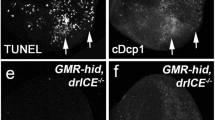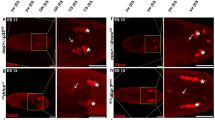Abstract
Here we identify a new gene, dark, which encodes a Drosophila homologue of mammalian Apaf-1 and Caenorhabditis elegans CED-4, cell-death proteins. Like Apaf-1, but in contrast to CED-4, Dark contains a carboxy-terminal WD-repeat domain necessary for interactions with the mitochondrial protein cytochrome c. Dark selectively associates with another protein involved in apoptosis, the fly apical caspase, Dredd. Dark-induced cell killing is suppressed by caspase-inhibitory peptides and by a dominant-negative mutant Dredd protein, and enhanced by removal of the WD domain. Loss-of-function mutations in dark attenuate programmed cell deaths during development, causing hyperplasia of the central nervous system, and other abnormalities including ectopic melanotic tumours and defective wings. Moreover, ectopic cell killing by the Drosophila cell-death activators, Reaper, Grim and Hid, is substantially suppressed in dark mutants. These findings establish dark as an important apoptosis effector in Drosophila and raise profound evolutionary considerations concerning the relationship between mitochondrial components and the apoptosis-promoting machinery.
This is a preview of subscription content, access via your institution
Access options
Subscribe to this journal
Receive 12 print issues and online access
$209.00 per year
only $17.42 per issue
Buy this article
- Purchase on Springer Link
- Instant access to full article PDF
Prices may be subject to local taxes which are calculated during checkout







Similar content being viewed by others
References
Jacobson, M. D., Weil, M. & Raff, M. C. Programmed cell death in animal development. Cell 88, 347–354 (1997).
Thompson, C. B. Apoptosis in the pathogenesis and treatment of disease. Science 267, 1456–1462 (1995).
Yuan, J. & Horvitz, H. R. The Caenorhabditis elegans cell death gene ced-4 encodes a novel protein and is expressed during the period of extensive programmed cell death. Development 116, 309–320 (1992).
Yuan, J., Shaham, S., Ledoux, S., Ellis, H. M. & Horvitz, H. R. The C. elegans cell death gene ced-3 encodes a protein similar to mammalian interleukin-1B-converting enzyme. Cell 75, 641–652 (1993).
Hengartner, M. O. & Horvitz, H. R. C. elegans cell survival gene ced-9 encodes a functional homolog of the mammalian proto-oncogene bcl-2. Cell 76, 665–676 (1994).
Vaux, D. L. & Korsmeyer, S. J. Cell death in development. Cell 96, 245–254 (1999).
Wu, D., Wallen, H. D. & Nunez, G. Interaction and regulation of subcellular localization of ced-4 by ced-9. Science 275, 1126–1129 (1997).
Chinnaiyan, A., O’Rourke, K., Lane, B. R. & Dixit, V. M. Interaction of ced-4 with ced-3 and ced-9: a molecular framework for cell death. Science 275, 1122–1126 (1997).
Spector, M. S., Desnoyers, S., Hoeppner, D. J. & Hengartner, M. O. Interaction between the C. elegans cell-death regulators CED-9 and CED-4. Nature 385, 653–656 (1997).
Zou, H., Henzel, W. J., Liu, X. S., Lutschg, A. & Wang, X. D. Apaf-1, a human protein homologous to C-elegans ced-4, participates in cytochrome c-dependent activation of caspase-3. Cell 90, 405–413 (1997).
Srinivasula, S. M., Ahmad, M., Fernandesalnemri, T. & Alnemri, E. S. Autoactivation of procaspase-9 by Apaf-1-mediated oligomerization. Mol. Cell 1, 949–957 (1998).
Hu, Y. M., Ding, L. Y., Spencer, D. M. & Nunez, G. WD-40 repeat region regulates Apaf-1 self-association and procaspase-9 activation. J. Biol. Chem. 273, 33489–33494 (1998).
Yang, X. L., Chang, H. Y. & Baltimore, D. Essential role of Ced-4 oligomerization in Ced-3 activation and apoptosis. Science 281, 1355–1357 (1998).
Li, P. et al. Cytochrome c and dATP-dependent formation of Apaf-1/caspase-9 complex initiates an apoptotic protease cascade. Cell 91, 479–489 (1997).
Zou, H., Yuchen, L., Xuesong, L. & Wang, X. An APAF-1/cytochrome c multimeric complex is a functional apoptosome that activates procaspase-9. J. Biol. Chem. 274, 11549–11556 (1999).
White, K. et al. Genetic control of programmed cell death in Drosophila. Science 264, 677–683 (1994).
Chen, P., Nordstrom, W., Gish, B. & Abrams, J. M. grim, a novel cell death gene in Drosophila. Genes Dev. 10, 1773–1782 (1996).
Grether, M. E., Abrams, J. M., Agapite, J., White, K. & Steller, H. The head involution defective gene of Drosophila melanogaster functions in programmed cell death. Genes Dev. 9, 1694–1708 (1995).
Song, Z. W., Mccall, K. & Steller, H. Dcp-1, a Drosophila cell death protease essential for development. Science 275, 536–540 (1997).
Fraser, A. G. & Evan, G. I. Identification of a Drosophila melanogaster ICE/ced3-related protease, drICE. EMBO J. 16, 2805–2813 (1997).
Chen, P., Rodriguez, A., Erskine, R., Thach, T. & Abrams, J. M. Dredd, a novel effector of the apoptosis activators Reaper, Grim, and Hid in Drosophila. Dev. Biol. 201, 202–216 (1998).
Dorstyn, L., Colussi, P. A., Quinn, L. M., Richardson, H. & Kumar, S. DRONC, an ecdysone-inducible Drosophila caspase. Proc. Natl Acad. Sci. USA 96, 4307–4312 (1999).
Inohara, N., Koseki, T., Hu, Y., Chen, S. & Nunez, G. CLARP, a death effector domain-containing protein interacts with caspase-8 and regulates apoptosis. Proc. Natl Acad. Sci. USA 94, 10717–10722 (1997).
McCall, K. & Steller, H. Facing death in the fly: genetic analysis of apoptosis in Drosophila. Trends Genet. 13, 222–226 (1997).
Rodriguez, A., Chen, P. & Abrams, J. M. Molecular prophets of death in the fly. Am. J. Hum. Genet. 62, 514–519 (1998).
Walker, J. E., Saraste, M., Runswick, M. J. & Gay, N. J. Distantly related sequences in the alpha- and beta-subunits of ATP synthase, myosin, kinases and other ATP-requiring enzymes and a common nucleotide binding fold. EMBO J. 1, 945–951 (1982).
Van der Biezen, E. A. & Jones, J. D. G. The NB-ARC domain: a novel signalling motif shared by plant resistance gene products and regulators of cell death in animals. Curr. Biol. 8, 226–227 (1998).
Stultz, C. M., Lathrop, R. H. & White, J. V. in Protein Structural Biology in Bio-Medical Research (ed. Woodward, N.A.a.C.) 22B (JAI, Greenwich, 1997).
Hofmann, K. & Bucher, P. The Card domain — a new apoptotic signalling motif. Trends Biochem. Sci. 22, 155–156 (1997).
Chou, J. J., Matsuo, H., Duan, H. & Wagner, G. Solution structure of the RAIDD CARD and model for CARD/CARD interaction in caspase-2 and caspase-9 recruitment. Cell 94, 171–180 (1998).
Kramer, H. & Phistry, M. Mutations in the Drosophila hook gene inhibit endocytosis of the boss transmembrane ligand into multivesicular bodies. J. Cell Biol. 133, 1–11 (1996).
Reed, J. C. Cytochrome C — can’t live with it — can’t live without it. Cell 91, 559–562 (1997).
Green, D. R. & Reed, J. C. Mitochondria and apoptosis. Science 281, 1309–1312 (1998).
Varkey, J., Chen, P., Jemmerson, R. & Abrams, J. M. Altered cytochrome c display precedes apoptotic cell death in Drosophila. J. Cell Biol. 144, 701–710 (1999).
Watson, K. L., Johnson, T. K. & Denell, R. E. Lethal(1)aberrant immune response mutations leading to melanotic tumor formation in Drosophila melanogaster. Dev. Genet. 12, 173–187 (1991).
Yoshida, H. et al. Apaf1 is required for mitochondrial pathways of apoptosis and brain development. Cell 94, 739–750 (1998).
Cecconi, F., Alvarezbolado, G., Meyer, B. I., Roth, K. A. & Gruss, P. Apaf1 (Ced-4 homolog) regulates programmed cell death in mammalian development. Cell 94, 727–737 (1998).
Bergmann, A., Agapite, J., McCall, K. & Steller, H. The Drosophila gene hid is a direct molecular target of Ras-dependent survival signaling. Cell 95, 331–341 (1998).
Kurada, P. & White, K. Ras promotes cell survival in Drosophila by downregulating Hid expression. Cell 95, 319–329 (1998).
Wu, D. Y., Wallen, H. D., Inohara, N. & Nunez, G. Interaction and regulation of the Caenorhabditis elegans death protease ced-3 by ced-4 and ced-9. J. Biol. Chem. 272, 21449–21454 (1997).
Hu, Y., Benedict, M. A., Wu, D., Inohara, N. & Nunez, G. Bcl-XL interacts with Apaf-1 and inhibits Apaf-1-dependent caspase-9 activation. Proc. Natl Acad. Sci. USA 95, 4386–4391 (1998).
Song, Q., Kuang, Y., Dixit, V. M. & Vincenz, C. Boo, a novel negative regulator of cell death, interacts with Apaf-1. EMBO J. 18, 167–178 (1999).
Inohara, N. et al. Diva, a Bcl-2 homologue that binds directly to Apaf-1 and induces BH3-independent cell death. J. Biol. Chem. 273, 32479–32486 (1998).
Poole, S. J., Kauvar, L. M., Drees, B. & Kornberg, T. The engrailed locus of Drosophila: structural analysis of an embryonic transcript. Cell 40, 37–43 (1985).
Bunch, T. A., Grinblat, Y. & Goldstein, L. S. Characterization and use of the Drosophila metallothionein promoter in cultured Drosophila melanogaster cells. Nucleic Acids Res. 16, 1043–1061 (1988).
Maniatis, T., Sambrook, J. & Fritsch, E. F. Molecular Cloning: A Laboratory Manual 2nd edn (Cold Spring Harb. Lab. Press, Cold Spring Harbor, 1989).
Chen, P., Lee, P., Otto, L. & Abrams, J. M. Apoptotic activity of REAPER is distinct from signalling by the tumor necrosis factor receptor 1 death domain. J. Biol. Chem. 271, 25735–25737 (1996).
Liu, X. S., Kim, C. N., Yang, J., Jemmerson, R. & Wang, X. D. Induction of apoptotic program in cell-free extracts — requirement for dATP and cytochrome c. Cell 86, 147–157 (1996).
Campos-Ortega, J. A. & Hartenstein, V. The Embryonic Development of Drosophila melanogaster (Springer, Berlin, 1997).
Rodriguez, A. et al. Identification of immune system and response genes, and novel mutations causing melanotic tumor formation in Drosophila melanogaster. Genetics 143, 929–940 (1996).
Acknowledgements
We thank J. Chapo, S.I. Ho and Y. Li for technical expertise; C. Klingerberg and T. Barrientos for help with mutagenesis; G. Lawton for electron microscopy; J. Waddle for photographic help; the Bloomington stock center for fly strains; C. Thummel for cDNA libraries; A. Fraser and G. Evans for drICE plasmids; and J. Agapite and H. Steller for the P[GMR-hid]-1M strain. This work was supported by grants from the NIA/NIH (R01 AG12466) and the NSF (MCB-9816841) (to J.M.A.) and from the American Cancer Society (Re258), NIH (GMR01-57158) and Welch Foundation (I1412) to X.W.
Correspondence and requests for materials should be addressed to J.M.A. The Drosophila genomic region containing the dark gene is contained in DNA located in GenBank under accession number AC004335. The dark cDNA has been submitted to GenBank under accession number AF162659.
Author information
Authors and Affiliations
Corresponding author
Rights and permissions
About this article
Cite this article
Rodriguez, A., Oliver, H., Zou, H. et al. Dark is a Drosophila homologue of Apaf-1/CED-4 and functions in an evolutionarily conserved death pathway. Nat Cell Biol 1, 272–279 (1999). https://doi.org/10.1038/12984
Received:
Revised:
Accepted:
Published:
Issue Date:
DOI: https://doi.org/10.1038/12984



